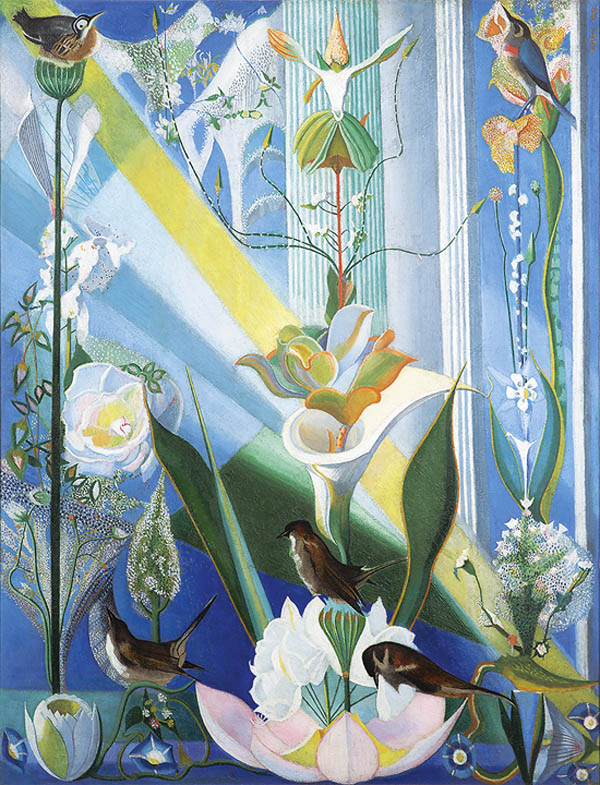Brandywine Museum Of Art To Present Joseph Stella: Visionary Nature
First Major Museum Exhibition Of Artist’s Nature-Based Works On View From June 17 To Sept. 24
June 16, 2023
This summer, the Brandywine Museum of Art will present the first major museum exhibition dedicated to the exquisite, nature-based works of pioneering American modernist painter Joseph Stella (1877-1946). On view Saturday, June 17, through Sunday, Sept. 24, Joseph Stella: Visionary Nature will feature more than 80 paintings and works on paper revealing the breadth of the artists multifaceted practice and his complex response to the spiritual qualities he felt in nature. The exhibition was initiated by the Brandywine and co-organized with the High Museum of Art, Atlanta, Ga. Stella is best known for the series of dynamic, futurist-inspired paintings of New York that launched his career, specifically of the Brooklyn Bridge and Coney Island, created between 1913-20. As this exhibition will reveal, he also created exuberant depictions of organic form for over three decades. His subjects included bold, stylized compositions featuring exotic plants and birds, religious works incorporating elaborate floral motifs, and tropical fantasies inspired by visits to North Africa and Barbados. Stella experimented with media ranging from silverpoint to watercolor to oil. His close observation and spiritual responses to nature shaped a poetically transcendent body of work that combines elements of realism and fantasy. We are thrilled to co-organize the first major exhibition of Joseph Stellas work since 1994, and the first that focuses exclusively on the artists work inspired by natural forms. Visionary Nature explores the context for this body of work, the artists inspirations, and the sources and stylistic influences behind their creation. As one half of an organization that includes the Brandywine Conservancy, the Museum is particularly attuned to artists who are inspired by nature, ranging from the landmark 2015 show devoted to Charles Burchfield to the four contemporary artists included in our recent Fragile Earth exhibition, said Thomas Padon, the James H. Duff director of the Brandywine Museum of Art. By assembling the best of his work from private and museum collections across the country, we are delighted to reintroduce the breadth of Joseph Stellas thrilling artistic vision to our visitors, added Padon. Born in a small town in the mountains of southern Italy, Stella immigrated to New York in 1896. He briefly attended medical school before studying with William Merritt Chase at the New York School of Art and Shinnecock Summer School of Art, from 1898 through 1901. Stella returned to Italy in 1909, spending the next several years in Europe and eventually making his way to Paris in 1912, where he was first exposed to the artistic strategies of Cubism, Futurism and Dada art. After his arrival back in New York in 1913, Stella established a reputation as a leading avant-garde artist whose work conveyed the energy of the city and modern life. Stellas most enduring acclaim came from his Cubist/Futurist body of work inspired by the Brooklyn Bridge. By 1919, however, a nostalgia for what he recalled as the blue distances of my youth in Italy and a visceral feeling of being suffocated by New York led Stella to turn away from urban imagery towards forms found in nature. Visionary Nature begins with works that demonstrate how Stellas exposure to Cubism, Futurism and Dadaism impacted his earliest nature-based subjects. Experimenting with color and materials, the artist produced luminous floral paintings on glass and employed natural materials like leaves and tree bark in innovative collages. The exhibition continues with a selection of Stellas silverpoint renderings of botanical form, a medium and subject that would engage him his entire career. Next is a selection of work that grew out of Stellas recurrent trips back to Italy after 1921, revealing a continued visual and metaphorical exploration of his roots. These paintings are light-filled landscapes with fulsome, often highly stylized flora and fauna; some even feature oversized Madonna figures, a direct reference to the liturgical traditions of his youth. Included also are studies of plants and flowers inspired by Stellas frequent visits to the New York Botanical Gardens and the elaborate, operatic compositions, full of drama and movement, that emerged from those visits, as well as his travels to Italy, North Africa and Barbados. Stellas 1937 journey to Barbados profoundly resonated with him, and he wrote ecstatically of its beauty and how it reinvigorated and inspired him, said Audrey Lewis, associate curator at the Brandywine Museum of Art and co-curator of the exhibition. When Stellas health began to suffer around 1940, however, he turned inward, creating small, exquisite silverpoints of flowers in his studio. These works would remain Stellas focus until his death in 1946. Joseph Stella: Visionary Nature is accompanied by a fully illustrated catalogue, published by the Brandywine and the High Museum of Art, featuring essays by Stephanie Heydt, the Highs Margaret and Terry Stent curator of American art and lead exhibition curator; Ara H. Merjian, professor of Italian studies at New York University; Ellen Roberts, curator of American art at the Norton Museum of Art, where the exhibition previously traveled; Karli Wurzelbacher, Heckscher Museum of Art curator; and an annotated timeline by the Brandywines Audrey Lewis. The Brandywine will be the final stop for this exhibition, which previously traveled to the Norton Museum of Art in West Palm Beach, Fla., and the High Museum of Art in Atlanta, Ga. Lead sponsorship is provided by the Henry Luce Foundation with major support from the Wyeth Foundation for American Art. At Brandywine, the exhibition is made possible with support from Chase and Cooper Robertson. For more information, visit www.brandywine.org/museum.



SHARE
PRINT